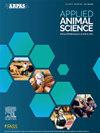Efficacy of ultrasonography to detect liver abscesses in cattle*
IF 1.5
Q3 AGRICULTURE, DAIRY & ANIMAL SCIENCE
引用次数: 0
Abstract
Objective
Our aim was to evaluate the use of ultrasonography to identify liver abscesses in cattle.
Materials and Methods
Finishing steers (n = 160, mean final BW = 649 kg) were used in Exp. 1 and Exp. 2 (n = 63, mean final BW = 593 kg). Liver abscess images were obtained 24 h before slaughter. Steers in Exp. 3 (n = 40; mean final BW = 168 kg) and 4 (n = 40; mean final BW = 159 kg) were beef × dairy steers used in a study to experimentally induce liver abscesses. Real-time ultrasound imaging of the liver was conducted on the day of slaughter.
Results and Discussion
In Exp. 1, the sensitivity of ultrasonography for detection of liver abscesses in finishing beef steers was 14.6%, and in Exp. 2 the sensitivity was 5.6%. In the lightweight beef × dairy steers, sensitivity was 50% in Exp. 2 and 41.1% in Exp 3. Ultrasound accuracy ranged from 70% to 75% within all 4 experiments. Specificity of ultrasonography ranged from 84.6% to 100% among all experiments.
Implications and Applications
Low sensitivity of detection in all experiments indicates ultrasonography has limited value for detecting liver abscesses in live cattle. Nonetheless, the greater specificity observed indicates that ultrasonography is effective at diagnosing a steer as negative, but the likelihood of detecting a negative is greater than detecting a positive because of the low prevalence of liver abscesses among the steers in each study. Even with modern ultrasound equipment with improved resolution, liver abscesses remain difficult to detect in live cattle, but sensitivity seems to be improved in lighter versus heavier weight cattle.
超声检查牛肝脓肿的疗效观察*
目的探讨超声在牛肝脓肿诊断中的应用价值。材料与方法试验1和试验2选用肥育阉牛(n = 160,平均末重649 kg) (n = 63,平均末重593 kg)。屠宰前24小时获得肝脓肿图像。试验3中的舵手(n = 40;平均最终体重= 168 kg)和4 (n = 40;平均最终体重= 159 kg)的牛×乳阉牛用于实验性肝脓肿的研究。在屠宰当天对肝脏进行实时超声成像。结果与讨论在实验1中,超声检查育肥牛肝脓肿的灵敏度为14.6%,在实验2中,超声检查肝脓肿的灵敏度为5.6%。在轻量级牛肉×乳牛中,试验2的敏感性为50%,试验3的敏感性为41.1%。在所有4个实验中,超声准确度在70%至75%之间。超声检查的特异性为84.6% ~ 100%。意义和应用所有实验的检测灵敏度都较低,表明超声在检测活牛肝脓肿方面的价值有限。尽管如此,观察到的更大的特异性表明超声检查在诊断阴性方面是有效的,但由于在每项研究中,肝脓肿的患病率较低,因此检测阴性的可能性大于检测阳性的可能性。即使使用分辨率提高的现代超声设备,肝脓肿仍然难以在活牛中检测到,但与体重较重的牛相比,体重较轻的牛的灵敏度似乎有所提高。
本文章由计算机程序翻译,如有差异,请以英文原文为准。
求助全文
约1分钟内获得全文
求助全文

 求助内容:
求助内容: 应助结果提醒方式:
应助结果提醒方式:


